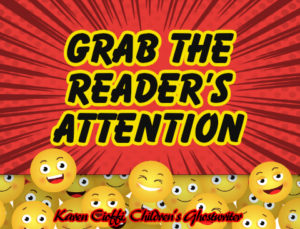
Contributed by Team Member Suzanne Lieurance
You can be a best-selling author!
Is that true?
Maybe. Maybe not.
But I’ll bet I got your attention with that statement.
And that’s exactly what you want to do if you hope to write novels and short stories (even nonfiction articles) that sell – grab your reader’s attention in the very first sentence.
Yet all too often beginning writers think they must set the scene for their story with extensive details, when all they really need to do is grab the reader’s attention.
Do you recognize any of these opening lines:
Call me Ishmael. ~ Herman Melville, Moby-Dick (1851)
It was the best of times, it was the worst of times, it was the age of wisdom, it was the age of foolishness, it was the epoch of belief, it was the epoch of incredulity, it was the season of Light, it was the season of Darkness, it was the spring of hope, it was the winter of despair.
~ Charles Dickens, A Tale of Two Cities (1859)
I am an invisible man. ~ Ralph Ellison, Invisible Man (1952)
They shoot the white girl first. ~ Toni Morrison, Paradise (1998)
It was a bright cold day in April, and the clocks were striking thirteen.
~ George Orwell, 1984 (1949)
Happy families are all alike; every unhappy family is unhappy in its own way. ~ Leo Tolstoy, Anna Karenina (1877; trans. Constance Garnett)
Notice how each of these openings pulls you in.
You don’t know who or what the author is talking about, but you can’t wait to find out.
Try this kind of thing in your own stories.
Here’s how:
1. Introduce a main character right away.
Something about this character needs to be intriguing, even if it’s only his name (as in “Call me Ishmael”).
But if you have an invisible man or a giant woman or a talking cow, let this character open your story and readers will be hooked and want to find out more.
2. Drop readers “into the middle of things” rather than give a lot of background narrative to set the scene.
If you read, “They shoot the white girl first”, you have no idea what’s going, or who the white girl is, but you can’t wait to find out.
This simple line implies so much!
3. Start with something that’s just a bit off the mark.
As in “the clocks were striking thirteen.”
What does that mean?
Does the author mean 1:00?
If so, why does he say thirteen?
Is this a military term?
Again, you’ve been pulled right into the story.
You know something about the setting of this tale is a bit out of the ordinary.
4. Compare and contrast something and do it in a pleasing and rhythmic way.
“It was the best of times, it was the worst of times” makes the reader wonder how it can be both the best and worst at once.
Plus, the rhythm of the sentence is pleasing to the ear and pulls in the reader.
These are just a few techniques that famous authors have used successfully.
These techniques will work for you, too.
And if you manage to grab the reader’s attention with the first sentence of your own novels and short stories, you just might become a best-selling author after all.
Try it!
Suzanne Lieurance is a freelance writer, the author of 30 published books and the Working Writer’s Coach. For daily writing tips and helpful resources, get your free subscription to The Morning Nudge at www.morningnudge.com.
 Whether you need rewriting or ghostwriting, let me take a look at your story. Just send me an email at: kcioffiventrice@gmail.com. Please put “Children’s Writing” in the Subject box.
Whether you need rewriting or ghostwriting, let me take a look at your story. Just send me an email at: kcioffiventrice@gmail.com. Please put “Children’s Writing” in the Subject box.
Or, give me a call at 347—834—6700
Let’s get your book in publishable shape today!
CHECK OUT MORE ARTICLES ON WRITING: